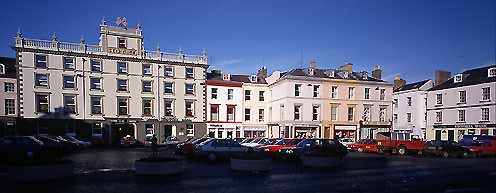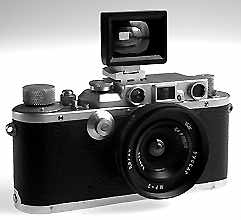

All these factors make the recent appearance in the West of KMZ-manufactured Russar 20mm f/5.6 Leica screw fit lenses of considerable interest. These Zeiss Biogon derivatives sell for around $450 including finder, and adapt inexpensively to non-TTL M-bayonet. Internal protrusion is 17mm: there is no way to machine down the rear. Non-RF-coupled, with its own finder, it's just as happy on an old screw body. Depth of field exceeds the (to 50cm) focusing range at f/11.
On the secondhand market, lens and finder may sell for under $300. A small ad in the British weekly magazine Amateur Photographer offered one 'as new' with finder for $250. The vendor had bought two in Russia, and was selling one to pay for both. The Russian street price is around $100 complete, but as these lenses are no longer manufactured and are only found in street markets the cost may rise when supplied dwindle.
The question is, of course, whether the Russar is any good. A 20mm stretches the limits of manufacturing tolerances; small misalignments can produce big image flaws. The construction is similar to other KMZ-built lenses, like the black Jupiter 50mm f/2 familiar from Zorkis. Light alloys are matt anodised, with engraved markings filled white. The screw thread and focusing action lack the finesse of steel on brass, and fitting this lens to a Leica IIIb body felt like re-cutting the thread.
The aperture setting is pre-war technology - inside the lens front, non-linear, without clickstops, from f/5.6 to f/22. Accuracy is only possible at the three wider apertures, as the gap between f/16 and f/22 is about the same as the width of the index dot. With a 49mm filter screwed into place, you can't get to the aperture setting. Most users will set the lens to f/11 and use the shutter speeds to control exposure.
The viewfinder is vastly inferior to Leitz models, has a tendency to produce unsharp zones if your eye is not exactly centred, calls for spectacle removal, and has manual parallax correction. It is not easy to see right to the edges. My finder is rectangular and bears the KMZ logo; it is thought to be a late or possibly hand-built variant. Most finders are circular with a front mask and very inaccurate indeed, lacking the parallax feature.
None of this inspires confidence.
Then you get the pictures back, and confidence returns! This lens is a cracker; sharp, free from geometric vices, vignetting just the right amount, blessed with a crispness, contrast and 'feel' superior to any SLR ultrawide. If anything the color is a little cool but it's really saturated and clean. The test conditions I shot under for the pic below were far from ideal - even at mid-day the sun doesn't rise high in January, and those shadows were a really cold skylight blue.

As the panorama above shows, the viewfinder gives accurate framing: the visual field just included the end of the hotel to the left, and so did the slide. A trace of divergence is present due to slight downward angling. There is no barrel distortion. Under high magnification the smallest fins of the television aerials on the central buildings are easily resolved. This view, by the way, shows The Cross Keys Hotel and one side of the market square in our home town of Kelso in Scotland - the largest market square in the country. The Scottish Borders is a great place for photography as well as salmon fishing - come here and see! Where else could you get intensity like the next picture without a polarizer, in January?
A full-frame shot (113Kb vertical 24-bit JPEG) shows the colour saturation, depth of field and corner-to-corner sharpness possible with this tiny Russian gem at f/16. What more can I say? It's turned an old Leica screw body into a useful, pocketable location camera.
One precaution which must be taken is to keep its front and rear elements absolutely clean. A spot on the front caused by a raindrop, as large as the aperture at f/22, was imaged as a slight dark spot on some frames. Cleaning the lens with care removed this. You can't really use a filter. Even a very slim one which I have gave slight vignetting at f/11. BUT - remember that a 20mm non-retrofocus lens like this, sticking well into the interior of the camera, gives a bigger format! On an old Leica, it shoots extra image detail out all round the edge of the frame, adding at least 1mm every way. The image goes right over the sprocket holes and there's only a hairline gap between frames. So maybe the vignetting would never show on a mounted slide (34.5 x 22.5mmm standard cropped area).
The Russar has variable availability; in Britain, try Mr Cad (+44 181 684 8282, fax +44 181 684 8835), or prepared to go through the fine print of private ads in Amateur Photographer magazine. I have no idea whether the lens is widely sold in Europe or the States, or how much for. Shutterbug would be the best place to look. If you can find one, especially if you own a serviceable Leica screw body, it represents a bargain which may not continue to be available for ever and is worth buying before such anachronisms cease to emerge from Russia. At the FOCUS show on February 27th, where we had our trade stand and launch of PHOTON, we could find only one example for sale.
This report is actually a bit longer than the single page text destined for the APRIL 1995 issue of PHOTOpro, but we have used the vertical shot full page at high resolution (20Mb color file) to show the sharpness. I just thought this lens was so good, and so exciting, I would put the report here in PHOTON right ahead of its time!
My thanks to David Tomlinson, organiser of the Russian Camera Collectors' Club, for correcting this article, and to Alex Falk of Mr Cad for diagnosing the finder variation and confirming the general price levels likely to apply to 'new' examples brought out of Russia by hand-picked 'researchers'! The RCCC is based at 128 Henwood Green Road, Pembury, Tunbridge Wells, Kent TN2 4LN, England, tel and fax +44 892 822032. A year's subscription with newsletters costs �10 sterling (UK), �15 (Europe), �20 (Rest of World) payable to RCCC in sterling cheque, money order or sterling cash - they don't accept credit cards.
- David Kilpatrick